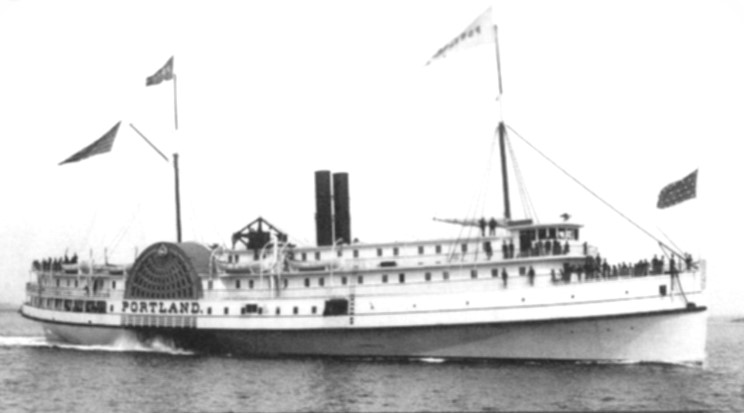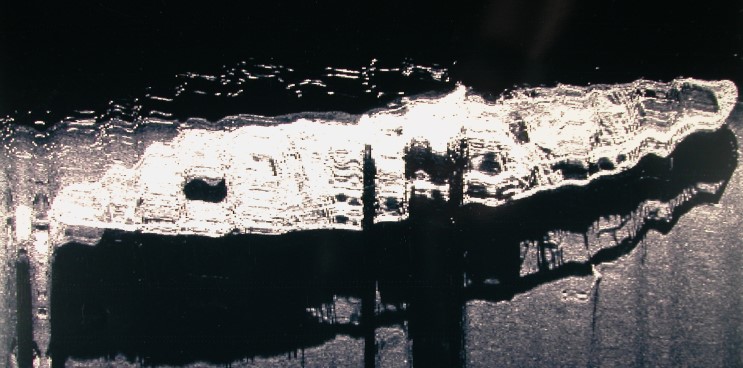|
On Nov.26, 1898 the side-wheel steamer Portland sank off Cape Cod, Mass. The Portland was built by New England Shipbuilding Co. of Bath, Maine, at a cost of $240.000. At 281 ft. long and displacing 2284 tons she was built for the Boston to Portland, Me route. Owned by the Portland Steam Packet Co. her and the Bay State made daily departures from the two cities. The voyage took about 8 to 9 hours. Portland operated for almost a decade with only one incident that I know of. On Sept. 8, 1895 she collided with the SS Longfellow. After the ships were separated, Portland continued on her voyage, but the Longfellow was heavily damaged. On the day after Thanksgiving, Nov.26,1898 the Portland was scheduled to depart Boston at 7 PM. Capt. Hollis Blanchard was aware that there was a storm approaching, and had been ordered not to sail until more information about the storm was known, however at 7pm. The Portland set sail anyway. Nobody knows why Blanchard decided to make the voyage. The Portland left the safety of the harbor and began her voyage into history. The storm, now known as the Portland gale (named after the ship) was really two storm fronts that collided. With winds reaching 90 mph, the storm lasted some 30 hours and left over two feet of snow on New England. It was the most powerful storm in memory and (not including the Portland) sunk or beached 120 vessels and killed 400 people. On the Portland it must have been horrible. In seas that were 40ft. or more and 90mph winds the ship must have been battered and beaten. The passengers, many of whom were returning after visiting their families on Thanksgiving, must have been terrified as they were tossed about on the ship. Many may have been killed before the ship sank. After the wreck was located it was discovered most of the ship's upper superstructure was missing and presumed destroyed by the storm. When the Portland failed to arrive in Maine, speculation was she was lost in the storm. It was not until the night of the 27th that bodies and debris from the ship washed up on Cape Cod. The public did not know of the disaster right away because the storm had downed the telegraph lines. None of the almost 200 people on board survived. About 40 bodies washed up over the next day or two. An expedition sponsored by the Boston Globe was launched within two weeks of the sinking, but nothing was found. In 1924 one Capt. Charles Carver brought up several items thought to be from the Portland in his nets. This was hardly noticed by anyone. However in 1945 the author Edward Row Snow became convinced that the items brought up in 1924 were from the Portland. He hired Al George to dive on the wreck, which was in 144 ft. of water. In July 1945 he declared the Portland had been found. A plaque was even placed at Highland Light on Cape Cod explaining about the wreck and telling that the wreck was 9 miles off the Cape. In 1978 it was proven that Snow's wreck was not that of the Portland, and a new expedition was mounted to locate her. After some ten years, in the fall of 1988, John P. Fish and H. Arnold Carr located the wreck. They kept the exact location secret because they wanted to insure the site would not be pillaged. In 1992, congress designated a 842 square mile area off the coast of Massachusetts the Gerry E. Studds Stellwagen National Marine Sanctuary, and Fish and Carr made sure the boundaries included the wreck of the Portland. They did not reveal the true location until 2002. It has since been photographed and filmed extensively. The wreck is in fairly good condition and will continue to be studied. |
© 2005 Michael W. Pocock MaritimeQuest.com |
 |
SS Portland
|
 |
Side scan sonar image of the wreck of the Portland |